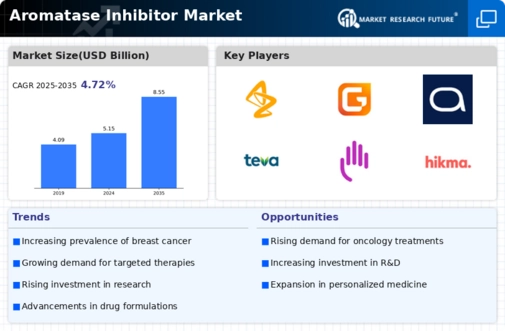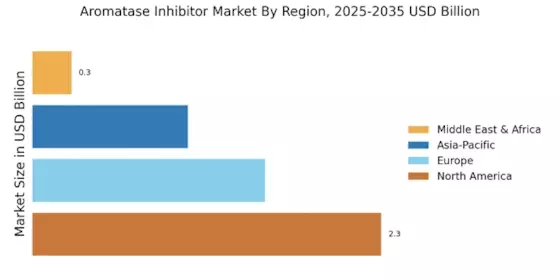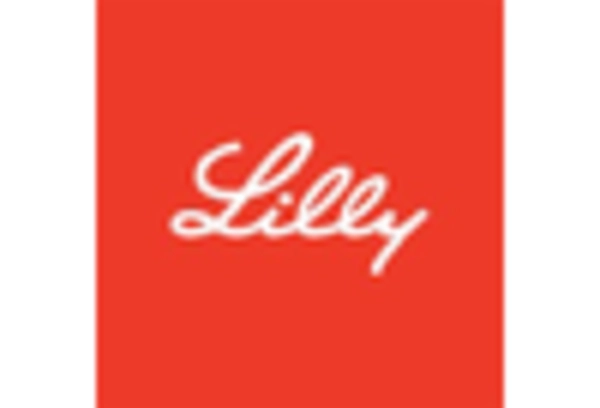Advancements in Clinical Research
Advancements in clinical research methodologies are significantly influencing the Aromatase Inhibitor Market. Innovative approaches, such as personalized medicine and biomarker identification, are enhancing the understanding of how aromatase inhibitors can be effectively utilized. Recent studies have demonstrated that specific patient populations may respond better to these therapies, leading to improved outcomes. The ongoing research into combination therapies, where aromatase inhibitors are used alongside other treatment modalities, is also gaining traction. This not only broadens the therapeutic landscape but also increases the potential market size for aromatase inhibitors. As clinical trials continue to yield promising results, the confidence in these agents is likely to bolster their adoption in treatment protocols, thereby driving growth in the Aromatase Inhibitor Market.
Rising Investment in Cancer Research
Rising investment in cancer research is a critical driver for the Aromatase Inhibitor Market. Increased funding from both public and private sectors is facilitating extensive research into the mechanisms of breast cancer and the role of aromatase inhibitors in treatment. This financial support is enabling the exploration of novel therapeutic strategies, including the development of next-generation aromatase inhibitors with improved efficacy and safety profiles. Moreover, collaborations between academic institutions and pharmaceutical companies are becoming more prevalent, leading to innovative research outcomes. As investment in cancer research continues to grow, it is likely to yield breakthroughs that enhance the understanding and application of aromatase inhibitors, thereby driving the market forward.
Regulatory Support for Oncology Drugs
Regulatory support for oncology drugs is a significant driver for the Aromatase Inhibitor Market. Regulatory agencies are increasingly prioritizing the approval of innovative cancer therapies, including aromatase inhibitors, to address the urgent need for effective treatment options. Streamlined approval processes and incentives for drug development are encouraging pharmaceutical companies to invest in research and development of new formulations and combinations. This regulatory environment fosters innovation and expedites the availability of aromatase inhibitors to patients. As a result, the market is likely to witness an influx of new products, enhancing competition and potentially lowering costs for consumers. The supportive regulatory landscape is thus a key factor in the ongoing expansion of the Aromatase Inhibitor Market.
Growing Awareness and Education on Breast Cancer
The growing awareness and education surrounding breast cancer are crucial factors propelling the Aromatase Inhibitor Market. Increased public health campaigns and educational initiatives have led to a better understanding of breast cancer risk factors, symptoms, and treatment options. As more individuals become informed about the benefits of early detection and treatment, the demand for effective therapies, including aromatase inhibitors, is likely to rise. Furthermore, healthcare professionals are increasingly emphasizing the importance of personalized treatment plans, which often include aromatase inhibitors for eligible patients. This heightened awareness not only encourages patients to seek timely medical advice but also fosters a more proactive approach to managing breast cancer, ultimately contributing to the growth of the Aromatase Inhibitor Market.
Increasing Incidence of Hormone-Receptor Positive Breast Cancer
The rising incidence of hormone-receptor positive breast cancer is a pivotal driver for the Aromatase Inhibitor Market. This type of breast cancer, which is sensitive to estrogen, has seen a notable increase in diagnoses, particularly among postmenopausal women. According to recent statistics, approximately 70% of breast cancer cases are hormone-receptor positive, necessitating effective treatment options. Aromatase inhibitors, which reduce estrogen levels in the body, are increasingly prescribed as a first-line therapy. This trend is expected to continue, as the demand for targeted therapies grows, thereby propelling the Aromatase Inhibitor Market forward. Furthermore, the aging population is likely to contribute to the rising number of cases, creating a sustained need for these therapeutic agents.


















Leave a Comment